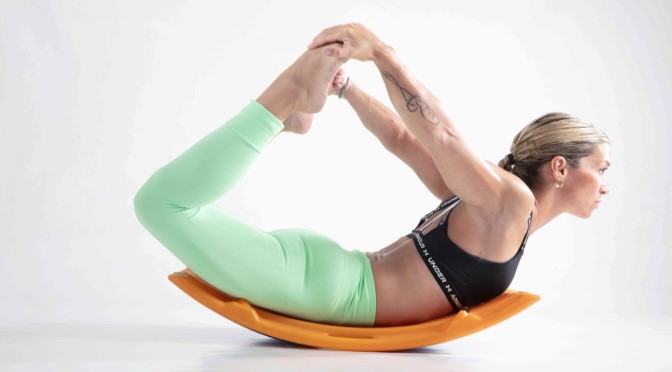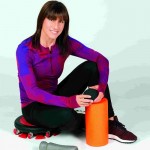The Bow Pose stretches the front of the body.
It is a Chest- and Heart-Opening Pose, a Strong Backbend Pose.
The Bow pose strengthens the back muscles and improves body posture.
It requires flexibility of the back muscles.
The pose step by step:
- Lie on the T-Bow® on your stomach. Keep your arms by your side with your palms up.
- Exhale and bend your knees bringing your heels as close to your buttocks as you can. Keep your knees hip width apart
- Reach back and take hold of the ankles or the top of the feet.
- Inhale and lift your heels away from your buttock pushing the thighs against the T-Bow®. Try to feel the back muscles soft.
- Adduct your shoulder blades and open your chest and your… heart.
- Keep the shoulders away from the ears and your gaze forward.
- Maintain the pose 20’’-30’’.
- Release gently with an exhale.
- Relax for a few breathes and then repeat it by rocking forward and backward.
With the T-Bow in an unstable position
- Keeps you in the pose with its shape. The bow pose reflects the shape of the bow of an archer and the same happens with the cave side of the T-BOW®.
- The T-Bow® has a curve of the natural-typical lumbar lordosis so this option is applicable to most of the trainees. In case someone has more mobility in the spine, the T-Bow® doesn’t limit it.
- Rocking forward and backwards stimulates the organs of the abdomen helping the digestive system.
- Rocking forward and backwards seems to be a play with gravity, so it either engages the back muscles more or it relieves them giving more emphasis to the stretch.
- Rocking forward and backwards relieves the stomach that is pressed into the floor. The breathing will be easier and the trainee will be able to focus on bringing the breath in the back of the body.
- The balancing on the T-Bow® is on one axis of imbalance (not two or multiple directions like semiballs, which makes it more difficult for many people).

Modifications & Variations
- The positioning in the new version of the wooden T-Bow® might be even more comfortable…(the trainee can put a thin mat if necessary).
- Executed on the top of a stable T-Bow® : from a pre stretched prone position.
- Executed in a double T-Bow® (cancave parts facing each other).
Varvara Solomonidou,Wellness Specialist, Personal Trainer, Seminar & Conference Lecturer, Pilates Master Trainer “AthensTrainers® Ultimate Pilates System®”, Member of Pilates Method Alliance (PMA), Member of European Lifestyle Medicine Organization (ELMO), DNAFit® Certified Trainer, Fascial Fitness Trainer, General Manager & Owner of AthensTrainers®
